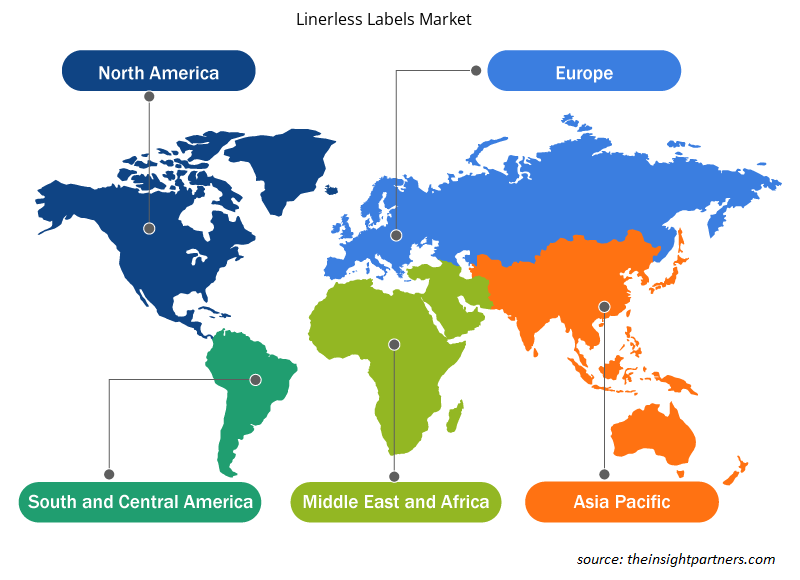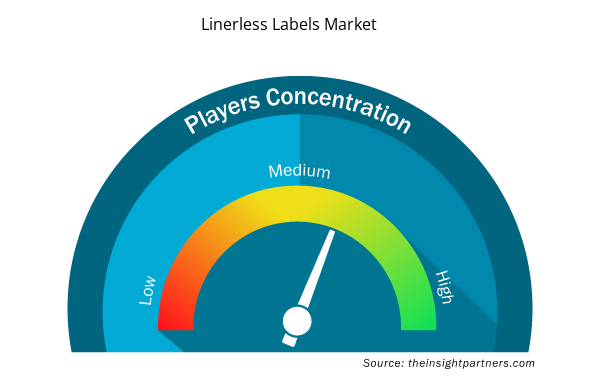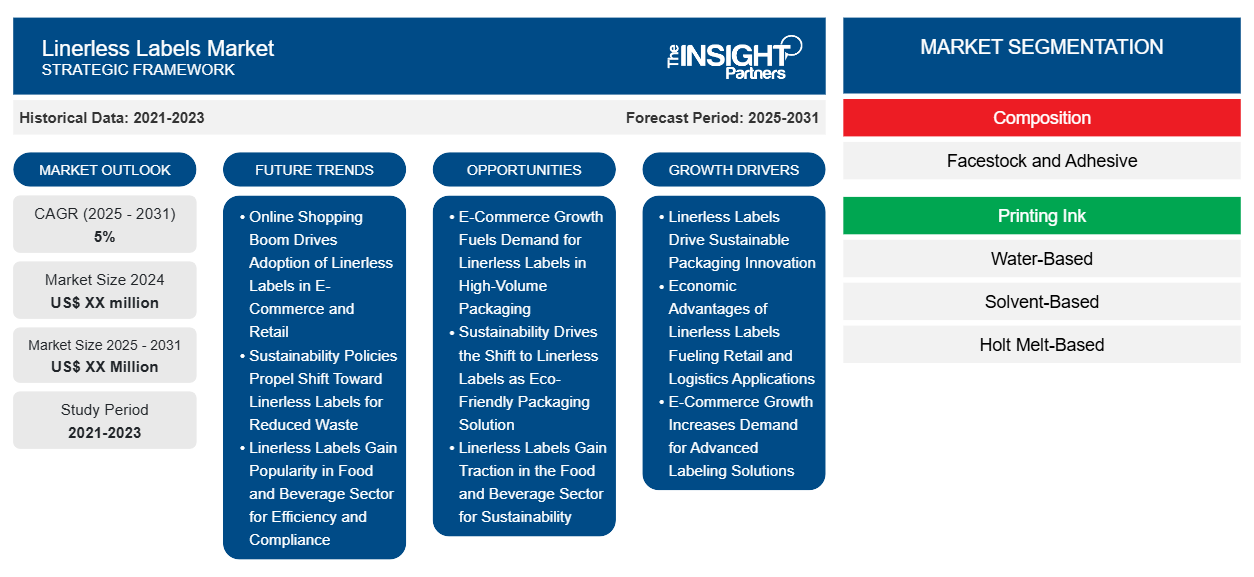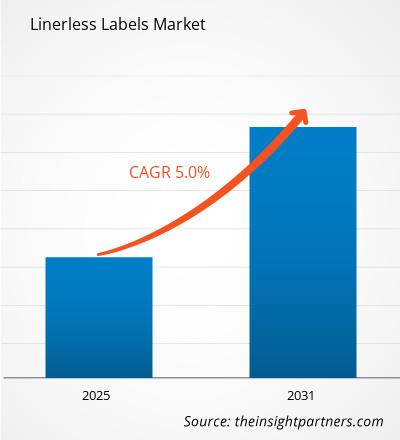Der Markt für Linerless-Etiketten wird voraussichtlich von 2024 bis 2031 eine durchschnittliche jährliche Wachstumsrate von 5 % verzeichnen, wobei die Marktgröße von XX Millionen US-Dollar im Jahr 2024 auf XX Millionen US-Dollar im Jahr 2031 wachsen wird.
Der Bericht ist nach Zusammensetzung (Obermaterial und Klebstoff) segmentiert. Die globale Analyse ist weiter auf regionaler Ebene und in die wichtigsten Länder unterteilt. Der Bericht präsentiert außerdem Analysen basierend auf Drucktinte (auf Wasserbasis, auf Lösungsmittelbasis, auf Holt-Melt-Basis, UV-härtbar). Die globale Analyse ist weiter auf regionaler Ebene und in die wichtigsten Länder unterteilt. Die Marktgröße und -prognose auf globaler, regionaler und Länderebene für alle wichtigen Marktsegmente werden im Rahmen des Berichts abgedeckt. Der Bericht bietet den Wert in USD für die oben genannte Analyse und die Segmente. Der Bericht bietet wichtige Statistiken zum Marktstatus der wichtigsten Marktteilnehmer und bietet Markttrends und -chancen.
Zweck des Berichts
Der Bericht Linerless Labels Market von The Insight Partners zielt darauf ab, die aktuelle Situation und das zukünftige Wachstum sowie die wichtigsten treibenden Faktoren, Herausforderungen und Chancen zu beschreiben. Dies wird verschiedenen Geschäftspartnern Einblicke geben, wie zum Beispiel:
- Technologieanbieter/-hersteller: Um die sich entwickelnde Marktdynamik zu verstehen und die potenziellen Wachstumschancen zu kennen, damit sie fundierte strategische Entscheidungen treffen können.
- Investoren: Durchführung einer umfassenden Trendanalyse hinsichtlich der Marktwachstumsrate, der finanziellen Marktprognosen und der Chancen entlang der Wertschöpfungskette.
- Regulierungsbehörden: Zur Regulierung von Richtlinien und Überwachungsaktivitäten auf dem Markt mit dem Ziel, Missbrauch zu minimieren, das Vertrauen der Anleger zu bewahren und die Integrität und Stabilität des Marktes aufrechtzuerhalten.
Linerless-Etiketten Marktsegmentierung
Zusammensetzung
- Obermaterial und Klebstoff
Druckfarbe
- Auf Wasserbasis
- Lösungsmittelbasiert
- Holt Schmelzbasiert
- UV-härtbar
Drucktechnologie
- Digitales
- Flexodruck
- Tiefdruck
- Bildschirm
- Lithografie
- Buchdruck
Geographie
- Nordamerika
- Europa
- Asien-Pazifik
- Süd- und Mittelamerika
- Naher Osten und Afrika
Passen Sie diesen Bericht Ihren Anforderungen an
Sie erhalten kostenlose Anpassungen an jedem Bericht, einschließlich Teilen dieses Berichts oder einer Analyse auf Länderebene, eines Excel-Datenpakets sowie tolle Angebote und Rabatte für Start-ups und Universitäten.
- Holen Sie sich die wichtigsten Markttrends aus diesem Bericht.Dieses KOSTENLOSE Beispiel umfasst eine Datenanalyse von Markttrends bis hin zu Schätzungen und Prognosen.
Wachstumstreiber für den Markt für Linerless-Etiketten
- Linerless-Etiketten treiben nachhaltige Verpackungsinnovationen voran: Leere Linerless-Etiketten gelten als eine der umweltfreundlicheren Verpackungsinnovationen, wenn man ihr minimalistisches Design und den geringeren Ressourcenverbrauch als herkömmliche Etiketten bedenkt. Da dieser Trend weiter zunimmt, werden Linerless-Etiketten im Rahmen der sichtbaren Veränderungen in der Branche als eine der Optionen für umweltfreundliche, nachhaltige Verpackungen angenommen.
- Wirtschaftliche Vorteile von Linerless-Etiketten für Einzelhandels- und Logistikanwendungen: Linerless-Etiketten sind wirtschaftlicher als herkömmliche Etiketten, da sie Materialverschwendung vermeiden und den Platzbedarf von Etikettenrollen minimieren. Da Unternehmen versuchen, ihre Verpackungsausgaben zu senken, werden diese Sektoren zunehmend im Einzelhandel und in der Logistik eingesetzt.
- Wachstum im E-Commerce steigert Nachfrage nach fortschrittlichen Etikettierlösungen: Die Expansion des E-Commerce und des Einzelhandels innerhalb kurzer Zeit hat den Bedarf an fortschrittlicher Etikettierung erhöht. Auch Haftetiketten, die bei hohen Geschwindigkeiten verwendet werden können, erfreuen sich bei der Produktkennzeichnung, Transportkennzeichnung und Logistik größerer Beliebtheit denn je.
Markttrends für Linerless-Etiketten
- Boom beim Online-Shopping treibt die Einführung von Linerless-Etiketten im E-Commerce und Einzelhandel voran: Das Wachstum beim Online-Shopping und der steigende Bedarf an Geschwindigkeit bei der Verpackung sind Schlüsselfaktoren, die zum Anstieg der Verwendung von Linerless-Etiketten führen. Sie reduzieren den Ressourcenbedarf und optimieren die nicht klebende Etikettierung, wodurch sie für den Einsatz in der Hochdurchsatzproduktion, einschließlich E-Commerce und Einzelhandel, geeignet sind.
- Nachhaltigkeitsrichtlinien treiben den Übergang zu trägerlosen Etiketten zur Abfallreduzierung voran: Da immer mehr Wert darauf gelegt wird, die Menge der verwendeten Verpackungen zu reduzieren, stellen trägerlose Etiketten eine Alternative dar. Trägerlose Etiketten gehen auf den Bedarf an Trägerpapier ein und lösen das Problem der übermäßigen Materialverschwendung, das in den letzten Jahrzehnten aufgrund zunehmender Nachhaltigkeitsrichtlinien bekämpft wurde, und werden daher von den meisten umweltbewussten Marken bevorzugt.
- Linerless-Etiketten werden im Lebensmittel- und Getränkesektor aufgrund ihrer Effizienz und Konformität immer beliebter: In jüngster Zeit wurden Linerless-Etiketten im Lebensmittel- und Getränkesektor zunehmend eingeführt, insbesondere für Produkte, die effektive und anspruchsvolle Etikettierprozesse erfordern. Sie sind einfach anzubringen, schonen das Budget und verursachen weniger Abfall, was insbesondere bei Lebensmittelverpackungen, bei denen Aussehen und Einhaltung von Vorschriften wichtige Elemente sind, häufig vorkommt.
Marktchancen für Linerless-Etiketten
- Wachstum im E-Commerce treibt Nachfrage nach Linerless-Etiketten für Großverpackungen an: Der Aufstieg des E-Commerce hat neue Möglichkeiten für Linerless-Etiketten geschaffen, die effiziente Etikettierlösungen für Produkte bieten, die direkt an Verbraucher versandt werden. Diese Etiketten sind gut für die wachsende Nachfrage nach schnellen, großvolumigen Verpackungsvorgängen geeignet und werden bei E-Commerce-Verpackungen immer häufiger zum Einsatz kommen.
- Nachhaltigkeit treibt den Wechsel zu Linerless-Etiketten als umweltfreundliche Verpackungslösung voran: Linerless-Etiketten sind eine nachhaltige Alternative zu herkömmlichen Etiketten mit Trägerpapier, da sie Materialabfälle reduzieren und vollständig recycelbar sind. Dieser Umweltvorteil macht Linerless-Etiketten zu einer großen Chance für Unternehmen, die ihre Umweltbelastung in der Verpackungsindustrie reduzieren möchten.
- Linerless-Etiketten gewinnen im Lebensmittel- und Getränkesektor aufgrund ihrer Nachhaltigkeit an Bedeutung: Linerless-Etiketten erfreuen sich im Lebensmittel- und Getränkesektor zunehmender Beliebtheit, wo sie zur Kennzeichnung von Frischwaren, verpackten Waren und Getränken verwendet werden. Mit zunehmendem Fokus auf Nachhaltigkeit und Reduzierung von Plastikmüll werden Linerless-Etiketten für umweltbewusste Lebensmittelmarken zur bevorzugten Option.
Regionale Einblicke in den Markt für Linerless-Etiketten
Die regionalen Trends und Faktoren, die den Markt für Linerless-Etiketten während des gesamten Prognosezeitraums beeinflussen, wurden von den Analysten von Insight Partners ausführlich erläutert. In diesem Abschnitt werden auch die Marktsegmente und die Geografie für Linerless-Etiketten in Nordamerika, Europa, im asiatisch-pazifischen Raum, im Nahen Osten und Afrika sowie in Süd- und Mittelamerika erörtert.

- Erhalten Sie regionale Daten zum Markt für Linerless-Etiketten
Umfang des Marktberichts über Linerless-Etiketten
| Berichtsattribut | Details |
|---|---|
| Marktgröße im Jahr 2024 | XX Millionen US-Dollar |
| Marktgröße bis 2031 | XX Millionen US-Dollar |
| Globale CAGR (2025 - 2031) | 5 % |
| Historische Daten | 2021-2023 |
| Prognosezeitraum | 2025–2031 |
| Abgedeckte Segmente | Nach Zusammensetzung
|
| Abgedeckte Regionen und Länder | Nordamerika
|
| Marktführer und wichtige Unternehmensprofile |
|
Marktdichte von Linerless-Etiketten: Auswirkungen auf die Geschäftsdynamik verstehen
Der Markt für Linerless-Etiketten wächst rasant, angetrieben von der steigenden Nachfrage der Endverbraucher aufgrund von Faktoren wie sich entwickelnden Verbraucherpräferenzen, technologischen Fortschritten und einem größeren Bewusstsein für die Vorteile des Produkts. Mit steigender Nachfrage erweitern Unternehmen ihr Angebot, entwickeln Innovationen, um die Bedürfnisse der Verbraucher zu erfüllen, und nutzen neue Trends, was das Marktwachstum weiter ankurbelt.
Die Marktteilnehmerdichte bezieht sich auf die Verteilung der Firmen oder Unternehmen, die in einem bestimmten Markt oder einer bestimmten Branche tätig sind. Sie gibt an, wie viele Wettbewerber (Marktteilnehmer) in einem bestimmten Marktraum im Verhältnis zu seiner Größe oder seinem gesamten Marktwert präsent sind.
Die wichtigsten auf dem Markt für Linerless-Etiketten tätigen Unternehmen sind:
- 3M Unternehmen
- CCL Industries Inc.
- Cenveo Corporation
- Constantia Flexibles Group GmbH 5 . Coveris Holdings SA
- Gipako
Haftungsausschluss : Die oben aufgeführten Unternehmen sind nicht in einer bestimmten Reihenfolge aufgeführt.

- Überblick über die wichtigsten Akteure auf dem Markt für Linerless-Etiketten
Wichtige Verkaufsargumente
- Umfassende Abdeckung: Der Bericht deckt die Analyse der Produkte, Dienste, Typen und Endbenutzer des Marktes für trägerlose Etiketten umfassend ab und bietet einen ganzheitlichen Überblick.
- Expertenanalyse: Der Bericht basiert auf dem umfassenden Verständnis von Branchenexperten und Analysten.
- Aktuelle Informationen: Der Bericht stellt durch die Abdeckung aktueller Informationen und Datentrends Geschäftsrelevanz sicher.
- Anpassungsoptionen: Dieser Bericht kann angepasst werden, um den spezifischen Kundenanforderungen gerecht zu werden und die Geschäftsstrategien optimal anzupassen.
Der Forschungsbericht zum Markt für Linerless-Etiketten kann daher dabei helfen, die Branchensituation und Wachstumsaussichten zu entschlüsseln und zu verstehen. Obwohl es einige berechtigte Bedenken geben kann, überwiegen die allgemeinen Vorteile dieses Berichts tendenziell die Nachteile.
- Historische Analyse (2 Jahre), Basisjahr, Prognose (7 Jahre) mit CAGR
- PEST- und SWOT-Analyse
- Marktgröße Wert/Volumen – Global, Regional, Land
- Branche und Wettbewerbsumfeld
- Excel-Datensatz


- Tortilla Market
- UV Curing System Market
- Lyophilization Services for Biopharmaceuticals Market
- Nuclear Decommissioning Services Market
- Electronic Toll Collection System Market
- Customer Care BPO Market
- Foot Orthotic Insoles Market
- Europe Tortilla Market
- Maritime Analytics Market
- Enzymatic DNA Synthesis Market

Report Coverage
Revenue forecast, Company Analysis, Industry landscape, Growth factors, and Trends

Segment Covered
This text is related
to segments covered.

Regional Scope
North America, Europe, Asia Pacific, Middle East & Africa, South & Central America

Country Scope
This text is related
to country scope.
Häufig gestellte Fragen
Growth in e-commerce and packaging automation is expected to be the key market trends
Based on composition, the feedstock segment is expected to witness the fastest growth during the forecast period
Based on geography, Asia Pacific held the largest share of the linerless labels market due to the well-established packaging industry across the region, coupled with continuous growth and development
Sustainability and eco-friendly packaging is driving the market growth
RR Donnelley & Sons Company
; Avery Dennison Corporation
; ITW (Illinois Tool Works)
; Brady Corporation
; Macfarlane Group PLC
; Herma GmbH
; Cenveo
; UPM Raflatac
; Sato Holdings Corporation
; MPS Group
; Sleever International
; Polyonics, Inc.
; Graphic Products
; PDC International
; Toppan Printing Co. Ltd.
The Linerless Labels Market is estimated to witness a CAGR of 5% from 2023 to 2031
Trends and growth analysis reports related to Chemicals and Materials : READ MORE..
1. 3M Company
2. CCL Industries Inc.
3. Cenveo Corporation
4. Constantia Flexibles Group GmbH
5 . Coveris Holdings S.A.
6. Gipako
7. Hub Labels
8. R.R. Donnelley and Sons Company
9. Ravenwood Packaging
10. Reflex Labels Ltd
The Insight Partners performs research in 4 major stages: Data Collection & Secondary Research, Primary Research, Data Analysis and Data Triangulation & Final Review.
- Data Collection and Secondary Research:
As a market research and consulting firm operating from a decade, we have published and advised several client across the globe. First step for any study will start with an assessment of currently available data and insights from existing reports. Further, historical and current market information is collected from Investor Presentations, Annual Reports, SEC Filings, etc., and other information related to company’s performance and market positioning are gathered from Paid Databases (Factiva, Hoovers, and Reuters) and various other publications available in public domain.
Several associations trade associates, technical forums, institutes, societies and organization are accessed to gain technical as well as market related insights through their publications such as research papers, blogs and press releases related to the studies are referred to get cues about the market. Further, white papers, journals, magazines, and other news articles published in last 3 years are scrutinized and analyzed to understand the current market trends.
- Primary Research:
The primarily interview analysis comprise of data obtained from industry participants interview and answers to survey questions gathered by in-house primary team.
For primary research, interviews are conducted with industry experts/CEOs/Marketing Managers/VPs/Subject Matter Experts from both demand and supply side to get a 360-degree view of the market. The primary team conducts several interviews based on the complexity of the markets to understand the various market trends and dynamics which makes research more credible and precise.
A typical research interview fulfils the following functions:
- Provides first-hand information on the market size, market trends, growth trends, competitive landscape, and outlook
- Validates and strengthens in-house secondary research findings
- Develops the analysis team’s expertise and market understanding
Primary research involves email interactions and telephone interviews for each market, category, segment, and sub-segment across geographies. The participants who typically take part in such a process include, but are not limited to:
- Industry participants: VPs, business development managers, market intelligence managers and national sales managers
- Outside experts: Valuation experts, research analysts and key opinion leaders specializing in the electronics and semiconductor industry.
Below is the breakup of our primary respondents by company, designation, and region:

Once we receive the confirmation from primary research sources or primary respondents, we finalize the base year market estimation and forecast the data as per the macroeconomic and microeconomic factors assessed during data collection.
- Data Analysis:
Once data is validated through both secondary as well as primary respondents, we finalize the market estimations by hypothesis formulation and factor analysis at regional and country level.
- Macro-Economic Factor Analysis:
We analyse macroeconomic indicators such the gross domestic product (GDP), increase in the demand for goods and services across industries, technological advancement, regional economic growth, governmental policies, the influence of COVID-19, PEST analysis, and other aspects. This analysis aids in setting benchmarks for various nations/regions and approximating market splits. Additionally, the general trend of the aforementioned components aid in determining the market's development possibilities.
- Country Level Data:
Various factors that are especially aligned to the country are taken into account to determine the market size for a certain area and country, including the presence of vendors, such as headquarters and offices, the country's GDP, demand patterns, and industry growth. To comprehend the market dynamics for the nation, a number of growth variables, inhibitors, application areas, and current market trends are researched. The aforementioned elements aid in determining the country's overall market's growth potential.
- Company Profile:
The “Table of Contents” is formulated by listing and analyzing more than 25 - 30 companies operating in the market ecosystem across geographies. However, we profile only 10 companies as a standard practice in our syndicate reports. These 10 companies comprise leading, emerging, and regional players. Nonetheless, our analysis is not restricted to the 10 listed companies, we also analyze other companies present in the market to develop a holistic view and understand the prevailing trends. The “Company Profiles” section in the report covers key facts, business description, products & services, financial information, SWOT analysis, and key developments. The financial information presented is extracted from the annual reports and official documents of the publicly listed companies. Upon collecting the information for the sections of respective companies, we verify them via various primary sources and then compile the data in respective company profiles. The company level information helps us in deriving the base number as well as in forecasting the market size.
- Developing Base Number:
Aggregation of sales statistics (2020-2022) and macro-economic factor, and other secondary and primary research insights are utilized to arrive at base number and related market shares for 2022. The data gaps are identified in this step and relevant market data is analyzed, collected from paid primary interviews or databases. On finalizing the base year market size, forecasts are developed on the basis of macro-economic, industry and market growth factors and company level analysis.
- Data Triangulation and Final Review:
The market findings and base year market size calculations are validated from supply as well as demand side. Demand side validations are based on macro-economic factor analysis and benchmarks for respective regions and countries. In case of supply side validations, revenues of major companies are estimated (in case not available) based on industry benchmark, approximate number of employees, product portfolio, and primary interviews revenues are gathered. Further revenue from target product/service segment is assessed to avoid overshooting of market statistics. In case of heavy deviations between supply and demand side values, all thes steps are repeated to achieve synchronization.
We follow an iterative model, wherein we share our research findings with Subject Matter Experts (SME’s) and Key Opinion Leaders (KOLs) until consensus view of the market is not formulated – this model negates any drastic deviation in the opinions of experts. Only validated and universally acceptable research findings are quoted in our reports.
We have important check points that we use to validate our research findings – which we call – data triangulation, where we validate the information, we generate from secondary sources with primary interviews and then we re-validate with our internal data bases and Subject matter experts. This comprehensive model enables us to deliver high quality, reliable data in shortest possible time.


 Holen Sie sich ein kostenloses Muster für diesen Bericht
Holen Sie sich ein kostenloses Muster für diesen Bericht